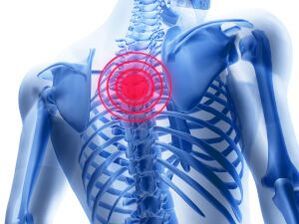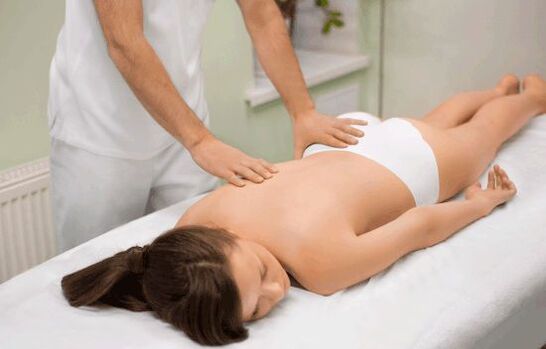
Clinically, thoracic osteochondrosis (chondrosis) is manifested by sharp, piercing or dull, painful pain, crunching and clicking when bending, stiffness.
The pathology is characterized by numerous specific symptoms such as shortness of breath, discomfort in the heart area and even a sore throat.
The treatment of the pathology is mostly conservative with pharmacological drugs. Physiotherapy procedures, massage sessions and chiropractors are also performed.
If such treatment is ineffective, the patient is shown surgery.
Details of the symptoms
The symptoms of osteochondrosis of the chest never appear all at once. In the initial stage of development of this degenerative-dystrophic pathology only slight discomfort in the back is noted. Patients accept them as banal fatigue after a hard day's work, write off the muscles "numb" due to a long stay in one position.
But the intensity of discomfort is slowly, steadily increasing. Unpleasant sensations are replaced by severe pain, complicated by limited range of motion, dizziness and headache. In medicine, all the symptoms of osteochondrosis at a given location are divided into several groups. This helps to diagnose more quickly and determine treatment tactics.
On a side note!The symptoms of thoracic osteochondrosis in men and women do not differ in nature, severity or location. But with the stronger sex, they can occur a little later due to the stronger musculoskeletal system. Also, some men have erectile dysfunction on the background of osteochondrosis.
Vertebral symptoms
Under the influence of adverse factors (hypothermia, increased physical activity) long-term remission of thoracic osteochondrosis may be interrupted by a sudden attack of acute pain. It is even more often provoked by a long stay in one body position, for example in a sitting position. If a person stands up abruptly, then there is such a sharp pain in the back that he loses his ability to move for a few minutes.
In medicine, this condition is called dorsago. It differs from ordinary pain in the accompanying symptoms:
- feeling short of breath when inhaling;
- severe stiffness.
The course of the pathology is often complicated by dorsalgia - chest pain, the intensity of which increases gradually. It increases with bending, turning the body to the side. In order not to feel pain, one takes a forced position. At the same time, it inadvertently tenses the muscles of the back, inadvertently provoking their overexertion. Now they also start to hurt, especially when walking.
Extravertebral symptoms
With the development of thoracic osteochondrosis, the intervertebral discs become thinner and more destroyed. These cartilaginous pads can no longer distribute the emerging loads, excluding the impact of the vertebrae against each other. The body's compensatory response is triggered - the bone structures begin to deform with the formation of growths. They compress sensitive nerve endings, disrupt the spinal canal. Therefore, there are specific symptoms of thoracic osteochondrosis in women and men: loss of sensitivity of certain parts of the body, burning sensation and creeping "goose bumps".
Important! Osteochondrosis of the chest is often manifested by a dry, unproductive cough, sore throat, a feeling of coma in it, as well as urinary disorders.
But that's not all. The spinal roots are responsible not only for the innervation (transmission of nerve impulses) of the spine, but also for the internal organs. Therefore, when they are disturbed, there are unpleasant sensations from the liver, kidneys, digestive tract, myocardium. What are the signs uncharacteristic of spinal pathologies manifested by thoracic osteochondrosis:
- pain in the heart area, identical to the recurrence of angina pectoris, shortness of breath, a feeling of "compression" of the heart;
- panic attacks, psycho-emotional instability, unfounded fear, anxiety, sleep disorders;
- epigastric discomfort, bouts of nausea, sometimes leading to vomiting, acid belching, bloating, boiling and rumbling in it;
- peristalsis disorders - constipation or diarrhea;
- prolonged, difficult breathing with sobs.
The pain is not localized directly at the site of the destroyed intervertebral disc and (or) the formed intervertebral hernia. They radiate along the nerve. Signs of osteochondrosis in the chest area can be disguised as renal colic, symptoms of gastritis, gastric ulcer, hepatitis, pancreatitis, cholecystitis and even gastroenteritis.
Compression myelopathy
This is the name of the extravertebral syndrome, which is rare in clinical practice. It is observed at 3-4 stages of the disease, when due to loss of stability of the spinal segment the pulpal nucleus protrudes beyond the fibrous ring. An intervertebral hernia forms, which constantly compresses the spinal cord. When meeting with a vertebrologist or neurologist, patients complain of frequent low back pain radiating to the groin area. At the same time there is a feeling of weakness, tingling in the lower extremities.
Against the background of the violation of the spinal cord, the innervation is seriously impaired. In the absence of treatment, the functional activity of the organs located in the pelvis decreases. Compression myelopathy causes bowel problems. And due to the pronounced narrowing of the diameter of the spinal canal, the sensitivity of the legs decreases. In severe cases, patients are diagnosed with paresis (partial or complete paralysis) of one or two lower limbs.
Symptoms of remission
Apart from recurrences, chest osteochondrosis hardly worries a person. Sometimes there is a pulling, painful, dull back pain that usually disappears after a long rest. But it is worth at least slightly increasing the load on the spine, lifting a heavy object or bending, as follows the next relapse. It can be caused by such factors:
- stressful situations, depressive states;
- hypothermia, sudden temperature changes;
- prolonged stay in one position of the body;
- alcohol abuse;
- unbalanced diet, lack of foods high in calcium, phosphorus, manganese, molybdenum in the diet.
Sometimes the remission phase ends because one tries to avoid a new relapse. He visits a chiropractor or masseur with a dubious reputation or little practical experience. Attempting to stretch the spine leads to another exacerbation.
The main methods of treatment
It is still not possible to completely cure the pathology, so all the efforts of doctors are aimed at improving the well-being of the patient. Patients are advised to wear orthopedic products (corsets, bandages), which fix the spinal structures, prevent their displacement. Drugs from different clinical and pharmacological groups are prescribed, physiotherapeutic measures and physiotherapeutic exercises are performed.

The movements of the chiropractor's arms are aimed at increasing the gaps between the vertebrae, which reduce thoracic osteochondrosis.
Important!In acute osteochondrosis of the chest, conservative treatment is useless. Patients are immediately offered surgery - excision of an intervertebral hernia, arthrodesis, placement of implants at the site of a damaged disc, bone grafting.
Drug therapy
The treatment of osteochondrosis of the chest is aimed at eliminating all symptoms, inhibiting destructive and degenerative processes. During periods of exacerbation, solutions for parenteral administration are used, which show effects after 5-10 minutes. The result is then consolidated by taking a course of tablets, applying ointments and gels. At the stage of remission are used mainly external means that have a more gentle effect on the body.
Non-steroidal anti-inflammatory drugs (NSAIDs)
This is the most commonly used group of drugs in the complex treatment of thoracic osteochondrosis. Their active ingredients block the biosynthesis of mediators of pain, inflammation and fever from arachidonic acids. Even after a single use of NSAIDs, a person's well-being improves significantly:
- the severity of the pain syndrome decreases;
- the unpleasant crisis that occurs when the body rotates and tilts disappears;
- inflammatory processes in the soft tissues weaken, the swelling subsides;
- the range of motion in the chest area increases.
Intramuscular solutions are used to stop recurrences. Preparations in capsules or tablets can cope with moderate pain. And ointments and gels quickly remove the slight discomfort.
Preparations with B vitamins
Preparations with B vitamins cope well with innervation disorders. They improve the transmission of nerve impulses to the central and peripheral nervous system, stimulate the recovery of damaged spinal roots. The composition of the agents is represented by thiamine, riboflavin, pyridoxine, cyanocobalamin.
During the first week of therapy, intramuscular administration of drugs that, in addition to vitamins, contain lidocaine, which immediately eliminates pain, is practiced. And then for a month patients are shown to take pills.
Glucocorticosteroids
The use of these synthetic analogues of hormones, which are produced by the adrenal glands, is practiced when safer agents are ineffective. Glucocorticosteroids are prescribed to patients with acute, stabbing back pain radiating to internal organs. The drugs can be taken orally, but are much more commonly administered parenterally, including at the sites of destroyed discs.
Glucocorticosteroids have a wide range of contraindications and potential side effects. Prolonged treatment of chondrosis of the thoracic spine with hormones leads to damage to the tissues of the liver, kidneys and stomach. So their use is prohibited in patients with cirrhosis, peptic ulcer, renal failure and osteoporosis.
Muscle relaxants
Back pain is often due to increased skeletal muscle tone. Muscle relaxants are used to relax it - first in the form of solutions for parenteral administration, and then in the form of tablets. The drugs relieve muscle spasm, which causes compression of the spinal root. Which muscle relaxants are most effective:
- blocking of polysynaptic reflexes;
- relaxing spasmodic muscles;
- reduction of prostaglandin secretion.
Drugs are rarely used as monotherapy. Treatment of thoracic chondrosis is performed with muscle relaxants in combination with glucocorticosteroids or nonsteroidal anti-inflammatory drugs. Their significant disadvantage is the rather rapid formation of dependence, so it is forbidden to use for more than a week.
Chondroprotectors
Unlike drugs that eliminate the symptoms of thoracic osteochondrosis, such drugs are also used for pathogenetic therapy. This is the only group of drugs that can increase the production of chondrocytes, which are needed for the partial recovery of cartilaginous intervertebral discs. All therapeutic effects of chondroprotectors are due to the high content of glucosamine and / or chondroitin.
But not only for the ability to repair discs, chondroprotectors are valued. Their components glow in the area of the damaged spinal segment. After 2-3 weeks, the maximum therapeutic concentration of glucosamine and chondroitin is established. Now the drugs begin to show pronounced analgesic, anti-inflammatory, anti-edematous activity.
Recommendation!It is recommended to treat osteochondrosis with chondroprotectors in the form of injectable solutions or tablets. Despite all the manufacturers' assurances about the effectiveness of ointments and creams, they cannot provide evidence for their therapeutic efficacy.
Treatment without drugs
Treatment of osteochondrosis of the chest with pharmacological drugs must be combined with regular physical education. Exercise therapy is the most effective method of therapy to avoid injury. Thanks to daily training, the muscular frame of the back and the ligament-tendon apparatus of the chest area are strengthened, the production of synovial fluid, which feeds the spinal structures, is improved. The complex of exercises is determined by the doctor of exercise therapy after studying the results of X-ray diagnostics. He attends the first classes, monitors the dosage of the loads.
Manual therapy of osteochondrosis is also practiced, aimed at increasing the gaps between the discs and the vertebrae. Dry or underwater pulling (pulling) of the spine is performed, and at home - hanging on the bar. The effectiveness of manual therapy increases with the simultaneous conduct of physiotherapy:
- electrophoresis;
- laser therapy;
- magnetic therapy;
- ultraviolet radiation;
- diadynamic currents.
Patients are shown 10-15 sessions of classical, vacuum, Scandinavian, acupressure. Hirudotherapy, acupuncture, balneotherapy with radon and hydrogen sulfide baths are also useful.
Only with the help of an integrated approach to the treatment of thoracic osteochondrosis is it possible to exclude further damage to the discs and deformity of the vertebrae. Following the doctor's recommendations helps to get rid of all the symptoms of chronic pathology as soon as possible.












































